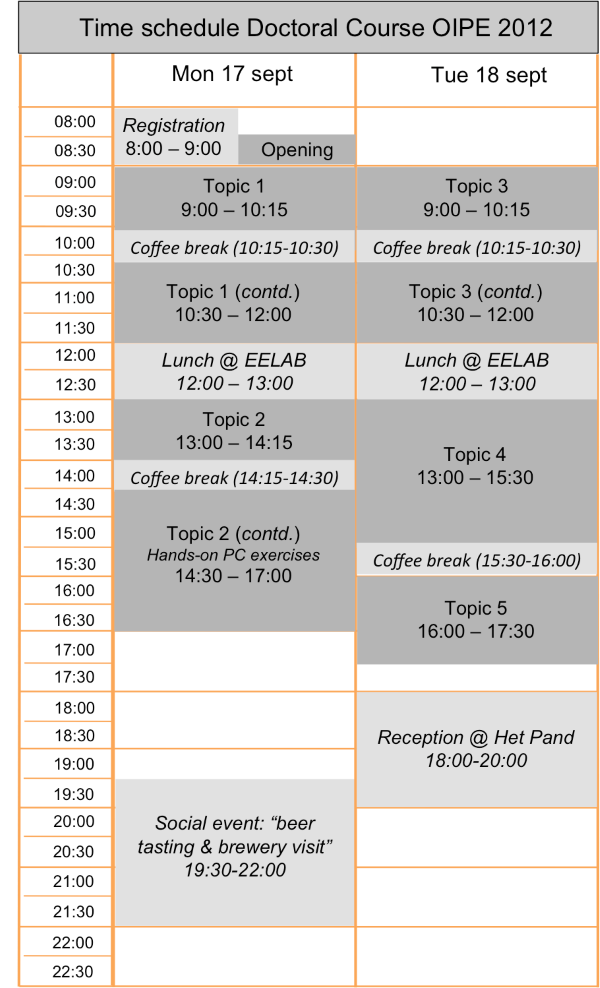Workshop
19-21 Sept, 2012Het Pand
Onderbergen 1, Ghent
• Program
• Registration
Doctoral Course
17-18 Sept, 2012Plateau
J. Plateaustraat 22,Ghent
• Program
• Registration
Important Dates
June, 1: Digest submission
June, 15: Digest acceptance
July, 1: Early registration
Oct, 8: Full paper submission
-
OIPE Workshop
-
Doctoral Course
-
Paper Info
-
Registration
-
Committees
-
Support
-
Organizing your Trip
-
About Ghent
Scientific Program
17th September:
Introduction [8h30 - 9h00] (dr. Guillaume Crevecoeur):
Overview of the different topics of the OIPE doctoral course and how they situate within the research field of Optimization and Inverse Problems in Electromagnetism.
Topic 1 [9h00 - 12h00] Numerical techniques for forward modeling (Prof. C. Geuzaine)
After a review of the basics of electromagnetism (Maxwell’s equations and constitutive laws) the lecture will focus on state of the art numerical methods for forward modeling, i.e., for the solution of Maxwell’s equations when the sources of electromagnetic fields as well as the material characteristics are assumed to be known a priori.
We will review the main families of methods, based either on differential (finite differences, finite elements, etc.) or integral (boundary elements and related techniques) formulations of the electromagnetic problem, and highlight their advantages and drawbacks for forward modeling in various settings: electromagnetic devices, non destructive testing, bio-electromagnetic applications, scattering problems, etc.
Topic 2 [13h00 - 17h00] Surrogate-based Modeling and Design (Prof. T. Dhaene, dr. D. Deschrijver)
The use of computer simulations has become standard practice in electrical and mechanical design, as building physical prototypes would be way too costly and time-consuming. However, due to the computational cost of high-fidelity simulations, the use of scalable behavioral or surrogate modeling techniques has become indispensable.
Surrogate models are compact and cheap to evaluate, and have proven very useful for tasks such as optimization, design space exploration, prototyping, and sensitivity analysis. Consequently, there is great interest in techniques that facilitate the construction of such behavioral models, while minimizing the computational cost and maximizing model accuracy. We present an algorithm that integrates adaptive modeling and adaptive sampling methods in order to generate an accurate global approximation over the design space of interest with a minimum number of electromagnetic simulations and/or measurements. By placing a strong focus on adaptivity, flexibility, and self-tuning the burden on the designer is relieved and the total design turn-around time is reduced.
18th September:
Topic 3 [9h00 - 12h00] Optimization methodologies: an overview (Prof. S. Koziel)
The lecture is an introduction to modern optimization techniques. Formulation of the optimization problem will be followed by the discussion of typical challenges that one may encounter while solving real-world optimization tasks: non-differentiability and non-smoothness of the objective functions, numerical noise, multiple local optima, computationally expensive functions, etc. We will talk about the classification of optimization methods, their relative strengths and weaknesses, as well as recommended areas of applications. The presented approaches will be explained using illustrative examples. Selected real-world test cases will also be presented.
During the lecture, a number of optimization techniques will be discussed in some detail, including basic gradient-based algorithms (e.g., conjugate-gradient, Newton- and quasi-Newton methods), derivative-free methods (pattern-search, Nelder-Mead algorithm), stochastic search techniques and meta-heuristics (random search, evolutionary strategies, genetic algorithms, particle swarm optimizers, differential evolution). We will also formulate the multi-objective optimization problem as well as typical solution approaches including scalarization, goal-attainment method as well as Pareto-front approach. Multi-objective optimization using evolutionary methods will also be addressed.
An important part of the lecture will be devoted to cover surrogate modeling and surrogate-based optimization (SBO) techniques. We will briefly discuss design of experiment techniques, various ways of constructing function-approximation and physically-based surrogate models, as well as some specific SBO algorithms (response correction techniques, space mapping, manifold mapping, surrogate management framework, etc.). Advantages and difficulties of SBO methods will also be discussed. Our considerations will be illustrated using a number of application examples, mostly from microwave engineering area.
Topic 4 [13h00 - 15h30] Inverse Problems in Brain Imaging (Prof. M. Clerc)
This course covers several electromagnetic modalitites used in brain imaging: the main focus is on electroencephalography (EEG), magnetoencephalography (MEG), and a secondary focus on diffuse optical tomography (DOT) and electrical impedance tomography (EIT).
The respective resolutions (in space and in time) depend on the types of biophysical variables that these modalities are sensitive to. These can be quite different since EEG and MEG measure the electric activity of cortical neurons, wheras DOT is sensitive to variations of blood oxygenation.
Identifying relevant information from these modalities requires both sophisticated signal processing (the signal-to-noise ratio is very weak) and inverse problem resolutions.
The corresponding forward and inverse problems will be presented, and the validation of results will be discussed.
The practical use of these imaging devices is in the cognitive sciences and in the clinical contexts. They help researchers and physicians to decide between competing hypotheses, in order to better understand, non-invasively, the functioning of the human brain.
Topic 5 [16h00 - 17h30] Short introduction to inverse problems (Prof. M. Slodi?ka)
The aim of this lecture is to give a short introduction to mathematical back- ground of inverse problems (IPs). Using a variational approach, an inverse problem can be reformulated as a minimization problem for a deliberately constructed cost functional in suitable function spaces. The ill-posedness of an inverse problem implies bad properties of that functional, which for instance can have several minima. Regularization methods for solving such problems will be discussed. Sensitivity analysis can be addressed using a unified framework.
Identifiability plays an important role by parameter identification in IPs. This question will be studied in several situations. Parameter determination in PDE’s from the overspecified data will be explained on various examples including non-local operators. A practical constructive method for solving will be discussed.
